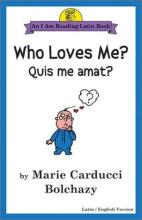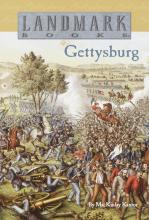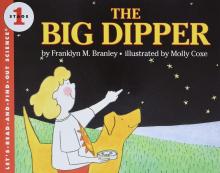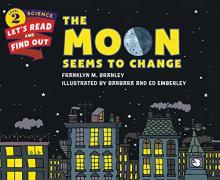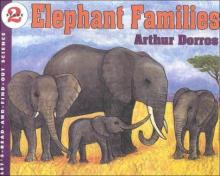No name
Who Loves Me? / Quis me amat?
This book introduces names of family members - mother, father, sister, brother, grandfather, grandmother, fraternal and paternal aunt and uncle, cousins and God - through the eyes of a baby. I liked how small details on some of the pictures - like the words on a T-shirt - are written in Latin (and the translations are included in the back along with the rest of the text). The text is charming, but these pictures are a bit on the "goofy" side (very cartoon like and some weird proportions). For me, the pictures detracted somewhat from the text (although I admit to being a person who is rather fussy about illustrations - particularly in children's books). Also, there is a slight editing problem on pages 13-14 where the illustrations of the paternal and fraternal aunts are mixed up.
Donated for review by Bolchazy-Carducci
Gettysburg
The Civil War Battle of Gettysburg, Pennsylvania (July 1 – 3, 1863) is a complex, multi-faceted piece of history that would be difficult to understand after reading just one book. If you ever find yourself in the South-Central Pennsylvania, I would recommend a visit. I've been there twice and it's very a moving, historically interesting site.
This book offers a glimpse into a number of aspects of the human side of the war. The author met with a number of Civil War veterans personally, and so the accounts contained within the book are very human and anecdotal. He tries to give us a sense of the flavor of life in that time period; the way people thought about each other – particularly those on opposite sides of the Potomac River.
Like many Landmark books, this probably isn't the first place you want to turn to in studying about Gettysburg – and this one isn't quite as cohesive as I would like. I think it would be most interesting and accessible to upper grade schoolers who had already become familiar with events in a general way from a textbook or from a visit to the battlefield. My 11 year old daughter tackled this independently this past year in the midst of other books on the civil war as well as bits and pieces of Ken Burns' Civil War documentary and enjoyed and benefited from it.
The Swamp Fox of the Revolution
Back in print! This interesting and entertaining story is a biography of Revolutionary War General Francis Marion and his significant but oft-forgotten role in winning our independence. Marion is a very interesting character I should have learned about in my history classes in grade school! He fought the British against what seemed like impossible odds (in the Southern Colonies) and ended up playing a very significant role in winning the British surrender. His courage and mercy (he allows his prisoners go free if they promise not to rejoin the other side) are admirable.
The reprint retains the index from the original Landmark book.
Originally published by Random House in 1959 as a Landmark book.
Reprinted 2008 by Sterling Point Books. Book details are for the reprint.
Language of God for Little Folks (Level D)
Designed for 4th or 5th grade, this level of the popular Catholic grammar curriculum is another winner! The book has been improved from the earliest editions of the lower levels by using a high-quality, bright-white, erasable paper with a lay-flat spiral binding. The 120 exercises in the worktext provide four short lessons per week for thirty weeks, including regular review of concepts already taught on lessons titled "Practice". There are no tests, although the "Practice" pages could be used as tests. The examples and exercises are gently Catholic, using bits of Catholic history, explanations of Catholic customs, and illustrations from daily family life as the sentences upon which the students practice. Pictures are simple black-and-white drawings and sketches and add to the simplicity of the book. It is very refreshing to use a text that is not filled with politically correct rhetoric and visually overwhelming photos and diagrams!
This level reviews grammar topics covered in earlier grades and extends these topics with grade-level information. A study of the parts of speech and their usage comprises the majority of the lessons. An introduction to traditional sentence diagramming (7 lessons) and sentence construction is also included (about 10 lessons). The exercises require very little actual pen-and-paper work and are ideal for a child who struggles with the physical act of writing. To practice a child's handwriting and to improve his retention, I have my children copy some of the daily practice sentences into their grammar notebooks, rather than just filling-in-the-blanks. For a student of this age, this text is not a complete language arts curriculum; you will also need regular composition exercises.
Copyrights 2001/2005
Language of God Level E
The Big Dipper
A very simple science book for children with cartoon-like pictures (nice cartoon, not cheezy-cartoon) that introduces some basic concepts about the stars. The very simple story line discusses looking at the night sky, that you see different stars in the summer and winter, where the big dipper got it's name, the names of the stars that make up the big dipper, how people can find direction from the North Star and the traditional constellation Ursa Major that the Big Dipper belongs to. The language is very simple, but not at all dumbed down - especially appropriate for preschool.
The Moon Seems to Change
This book, through simple illustrations and very readable text, gives young children (approximately Kindergarten thru third grade) an excellent explanation of the moon and the changes we can easily observe in it during a month. What often seem like complex concepts - the phases of the moon and its movement relative to the earth - are made very understandable through the text and a very simple experiment involving an orange stuck onto a pencil (a styrofoam ball stuck onto a chopstick worked quite well for us with less mess) and a flashlight. Naturally, it's recommended to do some real observations along with the book.
Many editions, 1960 onwards.
What Makes a Magnet?
What Makes a Magnet? constitutes a fairly substantial introduction to magnets for children approximately ages 5 to 9. They are invited to do a little discovery for themselves by doing some "fishing" with a magnet in a box of miscellaneous objects and see what things the magnet will pick up. The book goes on to explain that magnets pick up, not everything made of metal, but objects which contain iron in particular. Also explained are how to make your own magnet and compass, the poles of magnets and the earth, and the history of the discovery of the first magnets (lodestones) and how they were used for early navigation. This is a very nice early science book (despite a few "corny" pictures) because of the rich content in a simple format and how the book actively involves the child in the learning process.
Elephant Families
This book focuses on elephant's care for and interaction with each other with a significant emphasis on elephants being killed by poachers.
Unlike the interesting scientific information designed to impart facts and help children develop an interest in science (as I've come to expect from the Let's Read-and-Find-Out Science Series) this book gets lost in the mediocrity of environmentalism by giving children a sort of emotional attachment to elephants (by over-emphasizing their slight similarities with people) and shocking them with details about how and why people kill elephants and a somewhat gruesome (relative to the age-level) picture of a truck filled with blood-stained elephant tusks. Rather disappointing altogether.

